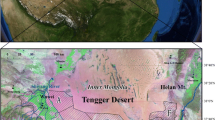Abstract
The possibility of applying remote sensing data to the identification and monitoring of desertification is demonstrated. The present study includes the investigation of desertification of the territory of Mongolia by the analysis of vegetation dynamics over the period from 1982 to 2016 and its interrelation with climatic, natural, and anthropogenic components. It is found that the main contribution to the vegetation degradation in Mongolia was made by precipitation decrease and air temperature rise. The indirect factors such as livestock, land cultivation, and wildfires increased the influence of climatic factors and gave impetus to the desertification in some arid and semiarid regions.
Similar content being viewed by others
References
The United Nations Convention to Combat Desertification in Those Countries Experiencing Serious Drought and/or Desertification, Particularly in Africa (September 12, 1994), https://doi.org/www.unccd.int/Lists/SiteDocumentLibrary/conventionText/conv-rus.pdf
E. V. Sherbenko, “Drought Monitoring from Satellite Data,” Sovremennye Problemy Distantsionnogo Zondirovaniya Zemli iz Kosmosa, No. 4, 2 (2007) [in Russian].
Z. Batjargal, Desertification in Mongolia, National Agency for Meteorology, Hydrology and Environment Monitoring, RALA Report No.200.
C. Bhuiyan, Desert Vegetation during Droughts: Response and Sensitivity, Jawaharlal Nehru University Delhi, School of Environmental Sciences.
X. W. Chuai, X. J. Huang, W. J. Wang, and G. Bao, “NDVI, Temperature and Precipitation Changes and Their Relationships with Different Vegetation Types during 1998–2007 in Inner Mongolia, China,” Int. J. Climatol., 33 (2012).
Climate Change Knowledge Portal, https://doi.org/sdwebx.worldbank.org/climateportal/DownloadData/tas5_1900_2012.xls.
Desertification and Land Degradation in Mongolia, https://doi.org/www.neaspec.org/sites/default/files/1.2%20Ms.%20Mandakh%20Nyamtseren.pdf/.
J. Fang, S. Piao, L. Zhou, J. He, F. Wei, R. B. Myneni, C. J. Tucker, and K. Tan, “Precipitation Patterns Alter Growth of Temperate Vegetation,” Geophys. Res. Lett., 32 (2005).
Fire Situation in Mongolia, https://doi.org/www.fire.unifreiburg.de/iffn/country/mn/mn_11.htm.
B. Gang, Q. Zhihao, B. Yuhai, Z. Yi, L. Wenjuan, and S. Amarjargal, “NDVI-based Long-term Vegetation Dynamics and Its Response to Climatic Change in the Mongolian Plateau,” Remote Sens., No. 9, 6 (2014).
Global Vegetation Health Products, https://doi.org/www.star.nesdis.noaa.gov/smcd/emb/vci/VH/.
F. N. Kogan, “Global Drought Watch from Space,” Bull. Amer. Meteorol. Soc., 78 (1997).
F. N. Kogan, “Vegetation Index for Areal Analysis of Crop Conditions,” in Proceedings of the 18th Conference of Agricultural and Forest Meteorology (Amer. Meteorol. Soc., West Lafayette, IN, 1987).
W. T. Lui and F. N. Kogan, “Monitoring Regional Drought Using the Vegetation Condition Index,” Int. J. Remote Sens., 17 (1996).
National Plan of Action to Combat Desertification in Mongolia (1997), https://doi.org/www.unccd.int/ActionProgrammes/mongolia-eng2000.pdf.
NCEP/NCAR Global Reanalysis Products, 1948–continuing, https://doi.org/rda.ucar.edu/datasets/ds090.0/.
NIES Global Land Cover Map, https://doi.org/db.cger.nies.go.jp/dataset/landuse/en/.
S. Piao, A. Mohammat, J. Fang, Q. Cai, and J. Feng, “NDVI-based Increase in Growth of Temperate Grasslands and Its Responses to Climate Changes in China,” Global Environ. Change, 16 (2006).
X. Zhao, K. Tan, S. Zhao, and J. Fang, “Changing Climate Affects Vegetation Growth in the Arid Region of the Northwestern China,” J. Arid Environ., 75 (2011).
X. K. Zou and P. M. Zhai, “Relationship between Vegetation Coverage and Spring Dust Storms over Northern China,” J. Geophys. Res. Atmos., 109 (2004).
Author information
Authors and Affiliations
Corresponding author
Additional information
Original Russian Text © A.A. Filei, L.A. Slesarenko, A.V. Boroditskaya, O. Mishigdorj, 2018, published in Meteorologiya i Gidrologiya, 2018, No. 9, pp. 61–71.
About this article
Cite this article
Filei, A.A., Slesarenko, L.A., Boroditskaya, A.V. et al. Analysis of Desertification in Mongolia. Russ. Meteorol. Hydrol. 43, 599–606 (2018). https://doi.org/10.3103/S1068373918090066
Received:
Accepted:
Published:
Issue Date:
DOI: https://doi.org/10.3103/S1068373918090066




